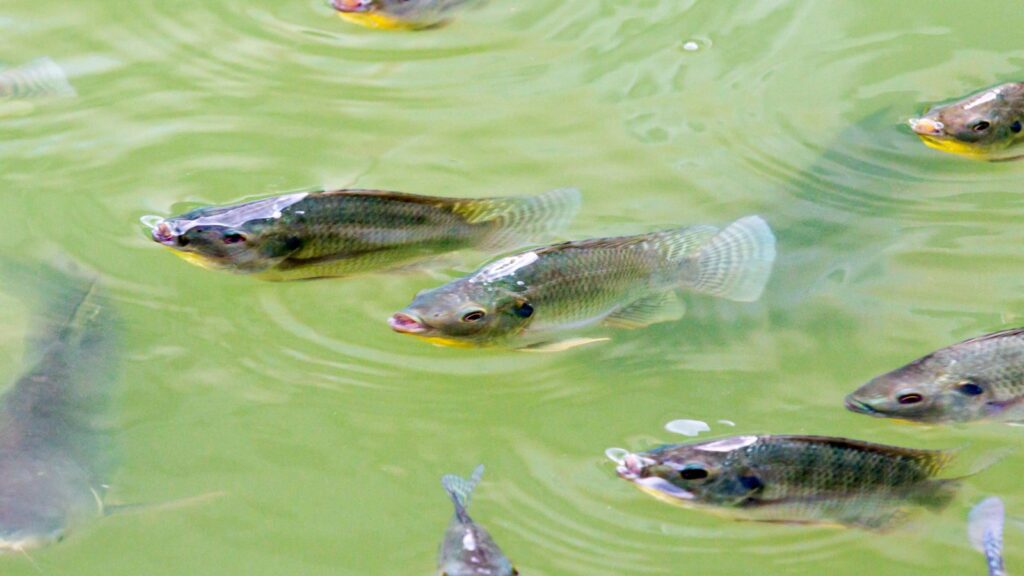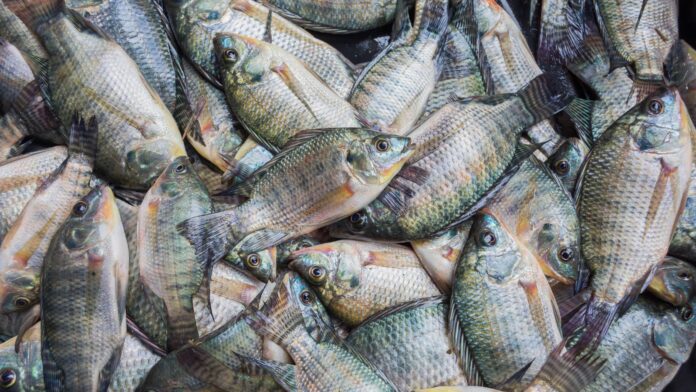Tilapia fishing is an engaging and rewarding hobby that can quickly become a fulfilling passion for outdoor enthusiasts. In our comprehensive guide, “Mastering Tilapia Fishing Techniques,” we provide valuable insights into the world of tilapia angling, explaining everything from essential gear to various techniques catered to beginners and expert anglers alike.
Dive in as we explore how to best capitalize on tilapia’s natural territorial behavior, pick the right tackle for different scenarios, and determine optimum times during their spawning season.
You’ll not only learn effective strategies for catching this versatile fish but also gain a newfound appreciation for this unique freshwater species.
Key Takeaways
- Understanding the natural behavior, habitats, and temperature preferences of Tilapia is crucial for successful fishing.
- Proper equipment selection with light leaders and small hooks are essential to attract nibbling fish while targeting shallow waters yields more significant results.
- Different techniques like bottom fishing, fly fishing, lure fishing and selecting bait such as corn or peas can help you succeed. Using a bobber or sinker method will also increase your chances of catching tilapia during spawning season with bright-colored lures or baits.
- Remember always to keep safety in mind when angling and practice responsible catch-and-release tactics to protect local ecosystems.
Understanding Tilapia Fishing
Understanding the habitat and behavior of tilapia is crucial for successful fishing, as well as identifying their habitats and using the best equipment.
Habitat And Behavior Of Tilapia
Tilapia thrive in warm, shallow waters and are commonly found in freshwater environments such as lakes, rivers, ponds, and even man-made reservoirs. Notably adaptable to various water conditions, these fish can survive in brackish waters as well.
Understanding the natural behavior of tilapia is crucial for successful fishing. These social fish often form schools when swimming and feeding throughout the day. They primarily feed on algae and plants but will occasionally consume small insects and crustaceans if other food sources are limited.
During spawning season, which usually occurs in spring or early summer depending on location, male tilapia become more territorial – guarding their nests while females lay eggs nearby.
Identifying Tilapia Habitats
To successfully catch tilapia, it is essential to first identify their habitats. Tilapia are found in both freshwater and brackish water bodies such as rivers, ponds, lakes, and even artificial water bodies like canals or dams.
These fish prefer calm waters with little or no current and tend to congregate near structures like logs, rocks or weeds where they will find shade and food sources. By understanding these preferences for cover and feeding grounds you can target specific areas with your bait or lure resulting in a higher chance of catching one.
Additionally, knowing the temperature requirements of tilapia will also help you locate them during different seasons; In warm weather months (65-85 degrees Fahrenheit), they will be most active in shallower waters while cooler temperatures may push them into deeper bodies of water where they can stay warmer.
Best Equipment For Tilapia Fishing
To catch tilapia, it’s essential to have the right equipment. A light spinning rod and reel with either monofilament or braided line is ideal for tilapia fishing. You’ll also need a basic tackle box that includes hooks, weights, swivels, and lures or baits like corn, peas, or bread balls.
In addition to the basics, having polarized sunglasses will help you see through the water surface while searching for tilapia habitats. A landing net may come in handy in case of larger catches that are hard to handle by hand alone.
Lastly, don’t forget safety gear such as sun protection (hat/sunscreen), life jacket if fishing from a boat/riverbank with strong currents and appropriate footwear to avoid slips while wading into the water.
Different Types Of Tilapia Fishing Techniques
Learn the different types of fishing techniques suitable for catching tilapia, including bottom fishing, fly fishing, lure fishing, bobber or sinker method, and selecting the right bait to attract tilapia.
Bottom Fishing
Bottom fishing is a popular technique used for tilapia fishing. It involves casting your line with bait or lures to the bottom of the water where tilapia usually feed and dwell.
To effectively use this method, you need the right equipment, such as a light rod and reel with an appropriately weighted sinker attached to your line.
One important aspect of bottom fishing for tilapia is having patience since they can be very cautious about what they eat and may not immediately take your bait. Additionally, understanding their feeding habits based on temperature and time of day can also improve your chances of catching them successfully.
Fly Fishing
Fly fishing for tilapia is a technique that involves using an artificial fly as bait. This method requires patience and skill, but it can be very rewarding. To start, you will need a specialized fly rod and reel with a floating line and tapered leader.
The key to successful fly fishing for tilapia is to mimic their natural prey, such as insects or small fish. Flies can be purchased online or at local fishing stores, or anglers can tie their own flies using materials like feathers and thread.
Lure Fishing
Lure fishing is a popular technique used to lure and catch tilapia. Lures are artificial baits that mimic natural prey, such as insects or small fish. There are different types of lures used for tilapia fishing, including jigs, spinners, and crankbaits.
One effective way to use lures is to cast them near vegetation or other areas where tilapia may be hiding. The key is to make the lure look as realistic as possible so that the fish will take the bait.
To excel in this technique, it’s essential to select lures carefully according to water conditions and focus on movement patterns with your retrieval speed while casting out into targeted areas repeatedly until you get a bite.
Bobber Or Sinker Method
One of the most popular techniques for tilapia fishing is using a bobber or sinker method. This technique involves attaching a small float, or a weight, to your fishing line to help you control the depth at which your bait travels in the water.
The bobber remains on top of the water and bobs up and down when tilapia bites it. This method works well with baits such as peas, corn, bread balls, or even dough bait. It’s important to adjust your float or sinker’s depth according to where fish are likely to be found – whether they’re swimming close to the surface or near the bottom.
Bait Selection (corn, Peas, Bread Balls)
Choosing the right bait is crucial in tilapia fishing. Corn, peas, and bread balls are popular options that can easily be found at home or nearby stores. These baits attract tilapia due to their bright colors, smell, and taste.
Additionally, they float on the surface of the water which increases visibility for both the angler and fish. However, anglers should keep in mind that different types of tilapia may have varying preferences when it comes to bait selection.
Light Leader And Tackle Selection
To catch tilapia successfully, it is crucial to choose the right equipment. An important aspect of this process is selecting a light leader and tackle for your fishing gear.
A light leader enables you to present your bait in a more natural way and increases sensitivity, which helps detect bites quickly. Typically, leaders should be between 1-3 feet long, with a test strength of 2-6 pounds.
Moreover, anglers can experiment with various techniques such as bottom fishing or fly fishing depending on their preference when trying to catch Tilapia effectively. Additionally understanding the behavior patterns of Tilapia like where they spawn and how they feed could help an angler decide what kind of tilt he/she needs.
Targeting Shallow Water
Fishing in shallow water is one of the best ways to increase your chances of catching tilapia. This is because shallow water provides tilapia with a safe and comfortable place to feed, mate, and rest.
To target shallow water, you need to identify the areas where tilapia are likely to be found. These include weedy banks, rocky shores, and underwater structures such as submerged trees or sunken boats.
Using light tackle and small baits can also help you attract more fish in these areas.
Fishing During Spawning Season
During the spawning season, tilapia are more aggressive and territorial, making it an excellent time to catch a big haul. Anglers can identify spawning season by observing male Tilapia creating nests for female fish to lay their eggs in shallow waters around the shoreline.
During this period, anglers should use bright-colored lures or bait and target shallower water closer to the shore. It is also essential to be patient and persistent as catching tilapia during this season may take a bit of time.
Using baits like bread balls with corn or peas has been proven effective during Tilapia breeding seasons, attracting them quickly towards your hook.
Keeping Distance To Avoid Scaring Tilapia
One essential tip for successful tilapia fishing is to keep an appropriate distance from the fish habitats, as they are easily spooked and will swim away. It’s crucial to approach quietly and stealthily so as not to scare them off.
In addition, it may be helpful to locate areas where there is less human activity and noise as this can impact the behavior of tilapia. By keeping a low profile, you increase your chances of having a successful catch.
Tips And Tricks For Successful Tilapia Fishing
Choose the right bait, cast your line in the right spot, be patient and observant, and be stealthy to increase your chances of catching tilapia.
Choosing The Right Bait
The type of bait you use when tilapia fishing can make all the difference in your success. Tilapia enjoy a variety of foods, and using the right bait can help you lure them to your hook.
Some popular options include corn, peas, and bread balls.
It’s important to keep in mind that different baits work better in certain types of habitats or during specific times of day or year. For example, dough bait may be more effective during the morning or evening when tilapia are most active near the surface of the water.
Casting Your Line In The Right Spot
One of the key factors for successful tilapia fishing is casting your line in the right spot. Tilapia are known to prefer shallow waters, so it’s important to target areas where they typically congregate such as near fallen logs, rock formations or submerged trees.
Look out for signs of feeding activity like ripples on the water surface and bubbles coming from below.
When casting your bait or lure, aim for structures that provide cover and shade since these places offer protection against predators and attract smaller fish that Tilapia love to feed on.
Casting in front of high grass at the edge of ponds can be particularly effective since these areas provide excellent hiding spaces for TIlapia . Remember not to scare off any potential catch by keeping a safe distance and using stealthy movements while casting your line.
Being Patient And Observant
One of the keys to successful tilapia fishing is being patient and observant. This means taking your time, watching for signs of activity in the water, and waiting for the right moment to cast your line.
It’s important not to rush or get frustrated if you’re not getting bites immediately.
Observation is also crucial when it comes to identifying where tilapia are located in ponds or lakes. Look for areas around vegetation, rocks, and other structures where they may be hiding out.
In addition, observe other factors such as weather conditions that could affect tilapia feeding patterns such as temperature changes ad barometric pressure changes which can indicate good times for fishing.
Being Stealthy
To increase your chances of catching tilapia, it’s essential to be stealthy. Tilapia can easily detect human presence and movement around the water body, so it’s crucial to keep a low profile and avoid making unnecessary noise.
It’s advisable to move slowly and smoothly around the fishing spot without disturbing the water or creating any ripples that may alarm the fish. Additionally, avoid wearing bright colors that could attract attention from tilapia or other fish in the area.
One way to be sneakier is by using a portable fish finder sonar device for kayaks or small boats instead of trolling motors as they are quieter with no noisy sounds disrupting activity underwater bringing you closer to catch more fish including tilapia which tends not to make too many movements at once when spooked because they’re very cautious creatures.
Using Dough Bait
Dough bait is a popular option for tilapia fishing, known for its success rate with this species. It’s made from flour, water and other ingredients such as cornmeal or cheese.
Many experienced anglers swear by the effectiveness of dough bait in catching tilapia. One advantage of using dough bait is that it can be molded into different sizes and shapes to suit the needs of the angler.
When preparing your dough bait mixture, it’s important to keep in mind that every fisherman has their own preferred recipe.
Another advantage of using dough bait is that it can be flavored with various additives such as garlic powder or vanilla extract to mask unwanted odors while attracting tilapia more effectively.
Additionally, if you’re searching for a fun DIY project before your next tilt at some Tilapias- making homemade Dough Bait is an excellent choice! Just take time to research some recipes online beforehand so you don’t waste time experimenting on unsuccessful trial runs.
Locating Tilapia In Ponds And Lakes

To locate tilapia in ponds and lakes, start by looking for places where they could be hiding or feeding. Tilapia prefer shallow water with vegetation or structures such as logs and rocks.
They tend to school together, so if you find one, there may be many more nearby.
Another effective method is to use a fish finder device that can detect the location of schools of fish underwater. Once you’ve located tilapia, try different bait types until you find what works best for them – corn, peas, and bread balls are popular choices.
Be patient and observant while fishing for tilapia since they can be sensitive to noise and movement- keep your distance from their habitat to avoid scaring them away.
Best Times To Catch Tilapia
Tilapia can be caught throughout the year, but there are certain times when they are more active and hence, easier to catch. Early morning or late evenings are usually the best time for tilapia fishing as the water is cooler and the fish tend to be more active.
Another ideal time for catching tilapia is during their spawning season, which typically occurs between May and August. This is a great opportunity to catch big fish as adults usually gather en masse in shallow waters during this period.
It’s important to keep a safe distance from them so that you don’t scare them away while casting your line.
Overall, mastering Tilapia Fishing Techniques requires patience and persistence, especially when trying out new techniques.
Fishing With Multiple Rods
An effective way to increase your chances of catching tilapia is by using multiple rods. This technique allows you to cover more water and use a variety of baits simultaneously.
When fishing with multiple rods, it’s important to keep in mind local regulations on the number of lines allowed per angler. Additionally, make sure that your equipment can handle handling multiple lines at once.
One popular method for fishing with multiple rods is setting up a “rod pod,” which holds several rods securely together in one spot. You can vary the bait types or depths across each rod to see what works best for attracting tilapia.
Another option is using sliding floats attached to each line so you can quickly adjust the depth of bait on each rod without re-tying knots or unhooking weights constantly.
Identifying Tilapia Behavior
Tilapia are a popular species for fishing, and understanding their behavior can improve your chances of catching them. Tilapia are generally territorial fish, meaning they tend to stay in one area of the water body.
They prefer warm waters with temperatures ranging from 75°F to 85°F.
To catch tilapia effectively, anglers must identify their habitat and feeding patterns. Tilapia feed on aquatic vegetation and insects found near the surface of the water body during daylight hours.
However, they tend to be less active during periods of high heat and bright sunlight. Understanding tilapia behavior is essential for selecting the right bait and using the appropriate technique required for successful angling.
Equipment And Gear For Tilapia Fishing
The guide includes information on the types of rods and reels suitable for tilapia fishing, as well as proper knot-tying techniques, landing nets, safety gear, and choosing the right line.
Types Of Rods And Reels
Choosing the right rod and reel is important when it comes to catching tilapia. The typical tilapia fishing setup includes a light spinning rod with a fast action, paired with a small reel.
This type of set up allows for greater sensitivity and control when casting, as well as feeling the bites from smaller fish.
It’s worth noting that different types of rods and reels are suited for specific techniques, so understanding which method you’ll be using can help you choose the right gear.
For instance, fly fishing requires specialized equipment such as lightweight rods that load quickly and accurate reels that allow easy line retrieval.
Choosing The Right Line
When it comes to tilapia fishing, choosing the right line is crucial for a successful catch. The type of line you use can make or break your chances of catching this elusive fish.
A great tip is to use a light monofilament line as it has minimal visibility in water and allows for more control over your bait.
Another option is braided line as it offers superior sensitivity and strength that lasts longer than other types of lines. Braided lines are perfect for bottom fishing where you need higher strength since tilapia tend to hide in cover beneath vegetation or rocks.
Ultimately, choosing the right line depends on factors such as water clarity and depth, target species size, casting distance, budget preferences among others.
Proper Knot Tying Techniques
When it comes to tilapia fishing, tying the right knot is essential for ensuring a smooth and successful angling experience. A poorly tied knot can result in lost fish or broken lines, which can be frustrating for any angler.
A popular knot used in tilapia fishing is the Palomar Knot, which has proven to be very reliable when it comes to securing light leaders. This knot offers great strength and makes sure that even if there’s a heavy strain on the line during casting or hauling your catch out of water, it will not cut through the leader material.
As simple as this may sound, many anglers make mistakes during tying knots because they do not learn from experts or practice enough beforehand.
Using A Landing Net
When it comes to tilapia fishing, using a landing net can be very helpful. A landing net is often used by anglers to help them safely and gently land their catch without causing harm or stress to the fish.
It also helps prevent the fish from falling off the hook while being lifted out of the water.
It’s important to choose a landing net that is appropriate for the size of your catch and made with materials that won’t damage or harm the fish. Ideally, you want one with soft mesh material that won’t cause any abrasions or injuries on their scales.
Safety Gear
It is important to prioritize safety when engaging in tilapia fishing. A life vest or personal flotation device (PFD) is a must-have for fishing on boats, especially if you are not an experienced swimmer.
Additionally, wearing polarized sunglasses can help reduce glare and improve visibility while on the water. It’s also advisable to wear rubber-soled shoes with good traction to prevent slipping on wet surfaces around the water.
Furthermore, it’s essential that you bring along a first aid kit in case of accidents or injuries related to your fishing activities.
Tilapia Fishing Regulations And Ethics
Know the laws and regulations when it comes to tilapia fishing, practice catch and release, respect the environment, and conserve tilapia populations.
Knowing The Laws And Regulations
It is crucial to understand the laws and regulations when it comes to tilapia fishing. Before engaging in any fishing activity, anglers must obtain a valid fishing license or permit for their state or country.
To conserve the tilapia population, many areas have implemented catch-and-release policies that require anglers to safely release all caught fish back into the water. It’s also important to respect the environment by properly disposing of bait and litter.
Respecting The Environment
As an angler, it’s essential to respect the surrounding environment when fishing for tilapia. It means leaving your fishing spot cleaner than you found it and being mindful of preserving natural habitats.
Additionally, using biodegradable baits like bread balls instead of commercial lures can reduce pollution in waterways.
Conserving Tilapia Populations
It’s crucial to conserve tilapia populations worldwide because this fish species provides a vital source of food for many people living off the grid. Overfishing, pollution, and habitat destruction threaten their existence.
By releasing the smaller or juvenile fish that are not yet mature enough to spawn back into the water, we give them an opportunity to grow and contribute towards repopulating the population.
Respecting their habitats by not polluting bodies of water with trash or chemicals also goes a long way in preserving this species’ numbers.
Conclusion
By following the tips and techniques outlined in this comprehensive guide, you can master the art of tilapia fishing. Whether you are a beginner or an experienced angler, this article provides all the necessary information needed to catch tilapia successfully.
By understanding their behavior and habitat, selecting the right equipment and bait, and using proper technique and timing, you can have a fulfilling fishing experience while respecting regulations and conservation efforts.
FAQs:
1. What are some effective tilapia fishing techniques to use when starting out?
Some popular techniques for catching tilapia include using live bait, such as worms or crickets, weighted bobbers to suspend bait at the right depth, and jigs with soft plastics or feathers that mimic small insects.
2. How can I locate areas where tilapia are likely to be found?
Tilapia tend to congregate near structures in shallow waters that provide cover from predators, such as submerged logs or rocks. They also prefer warmer water temperatures and may be attracted to areas with vegetation.
3. What types of gear do I need for successful tilapia fishing?
A light spinning rod with a sensitive tip paired with a reel spooled with 4-8 lb test line is usually sufficient for catching tilapia. In addition, a variety of hooks in sizes 6-12 and split-shot sinkers can help adjust your presentation based on conditions
4. Are there any specific regulations regarding the size or amount of tilapia you can catch?
Regulations vary depending on state and local laws but it’s important to check up-to-date guidelines before heading out on the water. Some locations have minimum size limits and daily bag limits per person so make sure you know what’s allowed before casting your line!




